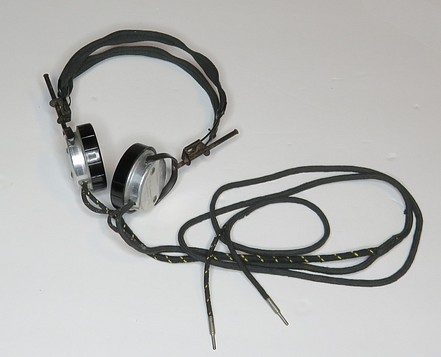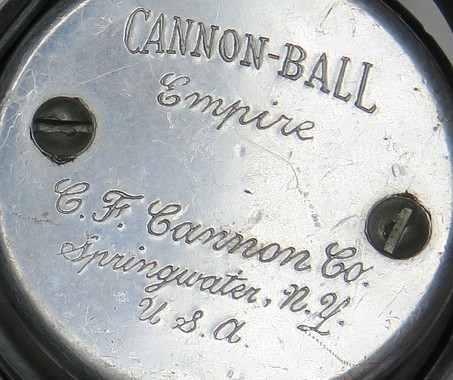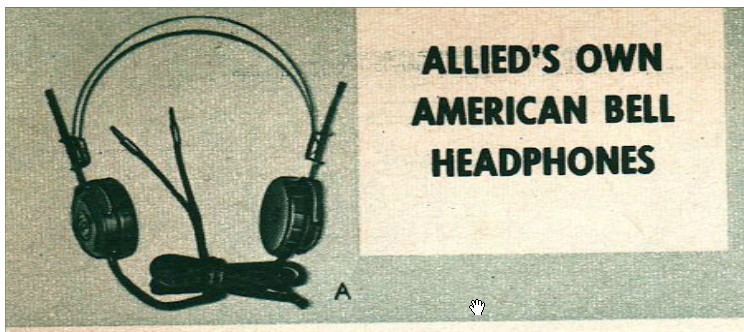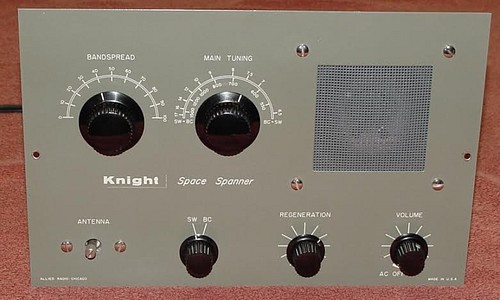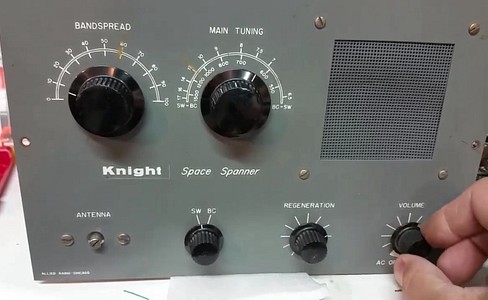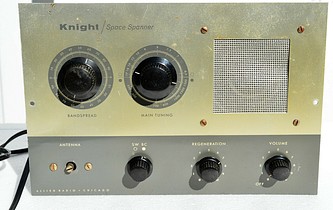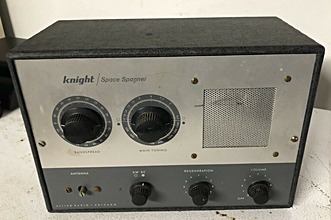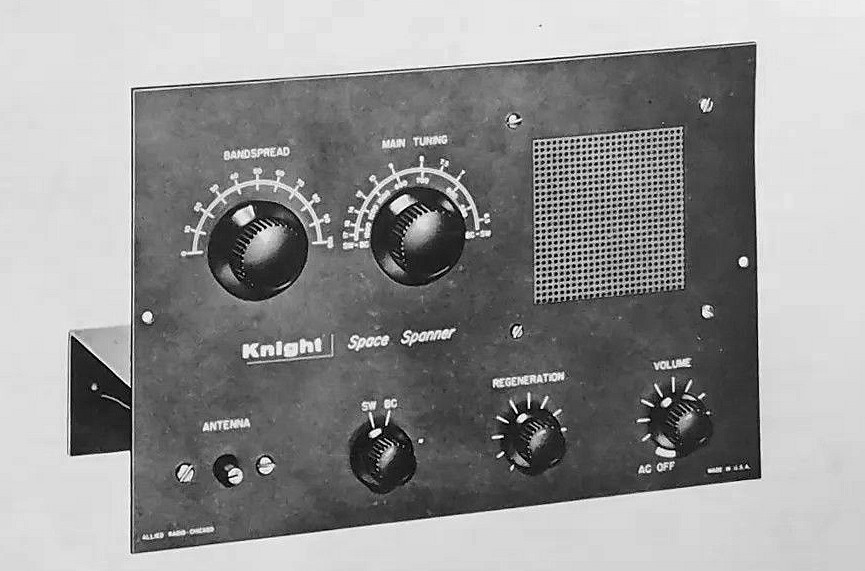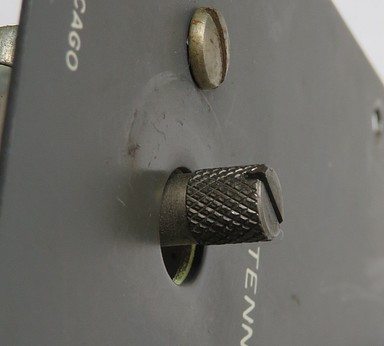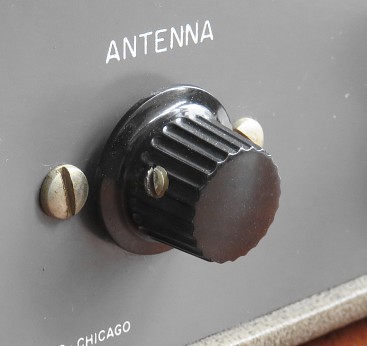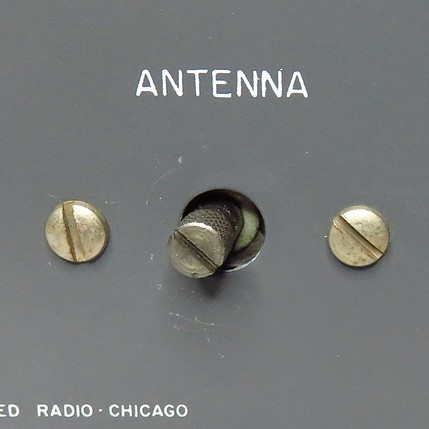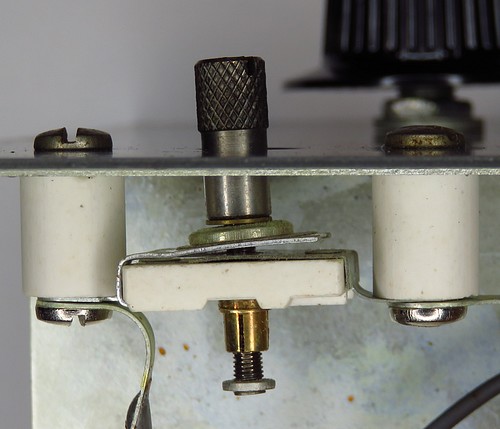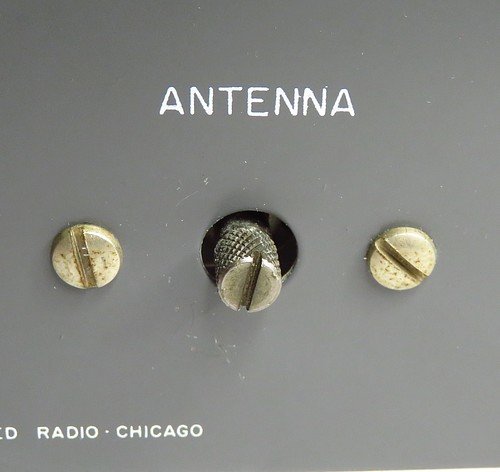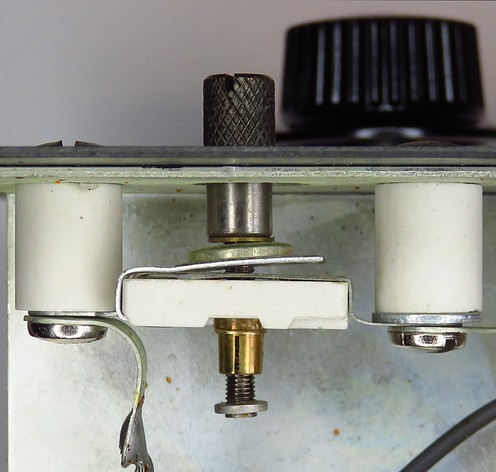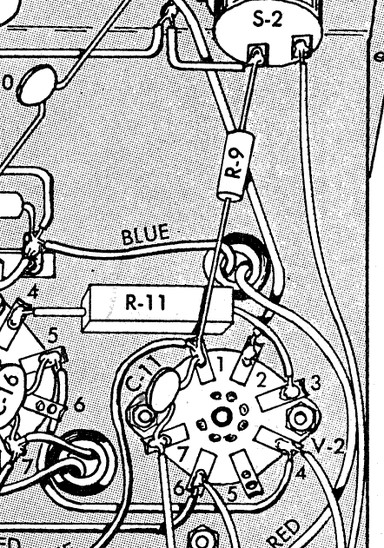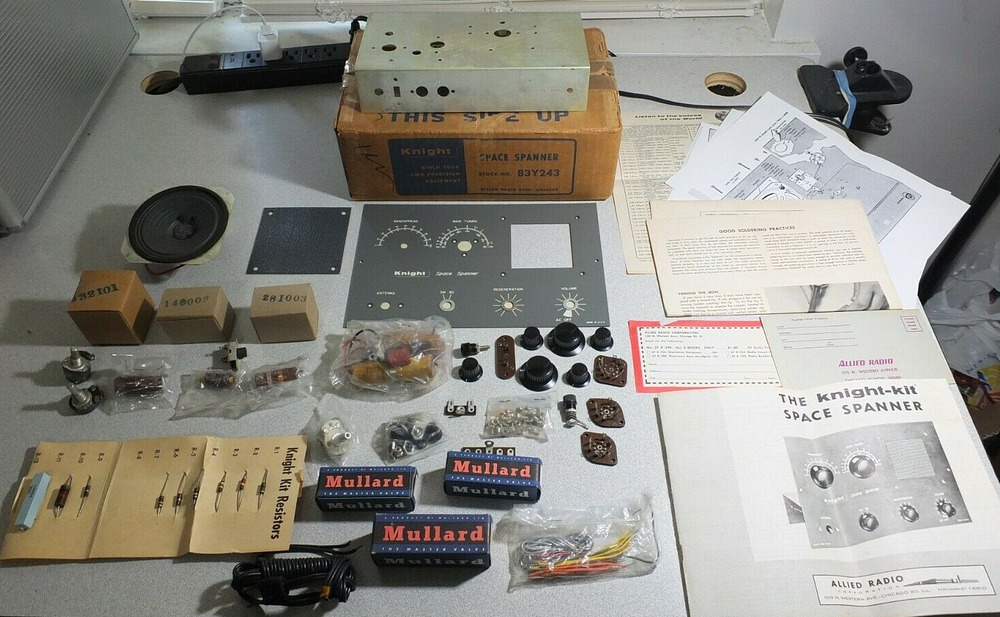|
|
|
|
|
|
Actor Morgan Freeman at the dials of a Space Spanner
when he was in the Air Force around 1956.
Click here
to see a rotated version of the photo. |
|
|
ACCESSORIES |
|
|
|
These headphones belonged to James Kasper
and came with the Space Spanner from ebay. Allied sold an
antenna and a pair of headphones to augment the radio.
I was hoping these would be the ones in the catalog.
Unfortunately, this headset doesn't even appear in the catalog. |
|
|
|
|
|
These are CANNON-BALL "Empires."
Allied carried CANNON-BALL "Master" and
"Chief" headphones in 1957 and '58, but not "Empire." |
|
|
|
|
| These are the Allied brand headphones
sold in the 1957 catalog next to the picture of the Space
Spanner. They were $2 and rated at 2000 ohms. An upgrade to
a CANNON-BALL "Chief" or "Master" would cost 22¢
or 44¢ more. |
|
|
|
|
|
MYSTERY of the MISSING KNOBS |
|
|
|
|
|
|
|
|
|
|
|
|
|
|
|
|
Why do so many Space Spanners have a missing knob on
the antenna tune control? |
|
|
|
|
|
|
|
One of the manuals shows the knob missing,
but the parts list shows FOUR knobs were included. |
|
|
|
|
On the left is a
photo of the antenna tune control before I cleaned the front
panel. From the mark on the panel, it is obvious that it once had a knob,
and the knob came into contact with the front panel. On
the right is the answer to the mystery, one of the
greatest mysteries of the 20th Century, second only to
whether or not Billy Shepherd replaced Paul McCartney.
The mystery has been solved!
See that backed out set screw in the picture on the right? It's the answer.
|
|
|
|
|
The instructions
in the manual say to remove the set screw. The reason for
this is that as you tune the antenna, the shaft on the
control moves inward or outward. A knob with a set screw
will prevent the control from moving inward when the knob
comes into contact with the front panel.
Without the set screw, the knob could come off if the shaft
on the control was recessed too far. That is the answer to
the mystery. The knobs are missing because THEY FELL OFF.
There is no reason why anyone should open the control so far
that the knob would fall off, but it was done. One person
told me he closed it so tightly he stripped the threads.
Some people boast they built a Space Spanner
when they were twelve years old. Maybe so, but some of them
didn't understand the function of the antenna tune capacitor
when they were twelve.
At any rate, Allied didn't sell a replacement knob! You can buy the knobs
today from Davies Molding (the manufacturer of the original Daka-Ware
knobs) but it's a lot easier to order from Antique
Electronic Supply. They are number 1600 and 1610.
Link
Can you actually "GENTLY force" something? "I'm going
to GENTLY force your hand into the garbage disposal."
"I'm going to GENTLY force you to give me all
your money." "I'm going to GENTLY force this
knife into your back"
It doesn't seem to work in all
situations.
|
|
|
POTENTIAL PROBLEM? |
|
|
|
|
|
The antenna tune capacitor
is not perpendicular to the front panel. It's
because of the "ears"
on either side, which are the electrical
connections. One comes from the front and the other
comes from the back. I tried bending them, but they
just flattened out again as the screws were tightened.
Fortunately, there is no electrical connection with
the shaft, so if the shaft comes into contact with
the front panel it won't affect the radio. However,
we can't have this, the situation is must be
resolved at all costs! |
|
|
|
|
|
A quick fix was to shim it with a washer on
one side.
Warning; The ceramic standoffs are fragile and can be ruined by over-tightening the screws. |
|
|
|
|
ANOTHER POTENTIAL PROBLEM? |
|
|
|
|
|
The big resistor in the filament string
(R-11) gets
hot. Resistor R-9 is in contact
with R-11. The instructions don't describe anything
different about soldering in R-9, but the drawing
does. It shows R-9 some distance away from R-11.
In ten minutes, R-11 reached a temperature of 192°F.
Is that a problem? When R-9 was heated by R-11 the
value went down by two ohms. It's connected to the
cathode of the 50C5 audio output tube. Considering
the schematic calls for a 180Ω resistor (10%
tolerance) but R-9 actually tests at 209Ω. I don't
think it makes any difference. It already exceeds
the 10% tolerance by 3 percent anyway.
R-11 was pushed closer to the chassis to put some
empty space between it and R-9. |
|
|
|
|
|
1963 - END OF THE SPACE SPANNER |
|
|
|
|
|
The Space Spanner had a short life of seven years.
In 1959, Knight added the Span Master to its
catalog of kits. It cost more but had sleek styling
and two additional bands. It also sported a "fine
regen" control for precision adjustment. This was
serious competition.
In 1963 the Knight Star Roamer kit appeared. The Star Roamer was a Superheterodyne radio
and had many advantages over the Space Spanner and
Span Master. It also had three times as many
parts and a price tag to match. In 1963 the Space
Spanner cost $18.95. The Star Roamer cost $39.95. In
2025 dollars that's $195
for the Space Spanner and $412 for the Star Roamer.
In 1964 the Space Spanner disappeared from the
Allied catalog. 1968 was the last year for the Span
Master. In 1970 the Span Master II was offered, but
it wasn't a regen radio. The price was $29.95
Note: These are "entry level" radio kits. You could
always spend $500.00 to $1000.00 on a communication
receiver if you had the money. See the link to the
catalogs at the bottom of the next page.
By the way, In 2020 I paid about $160 for the Space Spanner,
so I got it at the 1963 price! (Adjusted for
inflation, of course.) The worth of these radios
barely keeps up with inflation, but the
headphones I got with the radio have gone up in
value about 20-fold. |
|
|
|
|
|
|
Here's an unassembled
Space Spanner. Photo from an ebay auction (I didn't bid on
it).
If you owned this, would you assemble it? |
|
|
|
| |
|
|
| |




